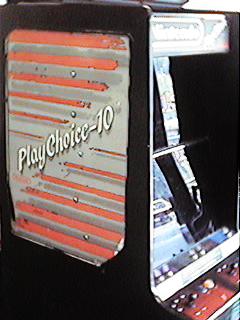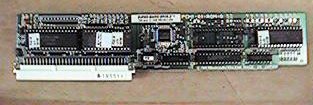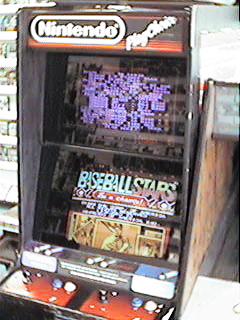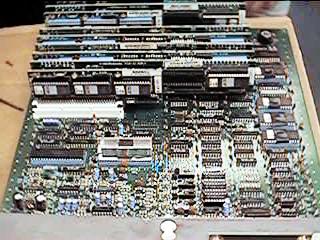 If you've ever entered an arcade in the early 90's, then you've surely seen a PlayChoice-10 machine or two, perhaps even with a light gun attached. Although you probably won't find one in any arcade today, they're still out there - at arcade auctions, in people's garages and - if you're nearby - in Mike Etler's shop in New Jersey. (I do too much free advertising for him, don't i?)
After choosing a game, the bottom screen would basically act like your NES, showing the title screen. The top screen, the really nice point about PlayChoices, displays instructions and hints for the game in pages that you can flip through via the panel buttons. Although the instructions were mostly text, some games' documentation (like Super Mario Bros.) had non-animated graphics as well. You can get an additional 300 seconds of time by inserting another quarter at any time. If you run out of play time (which has no relation at all to how well you do in the game itself) the bottom screen goes black and the top screen gives you 20 seconds to insert a coin. Put one in and the game springs back into action. Although the NES games in a PlayChoice were no match for the arcade machines of the time, PlayChoices became popular simply because they let you try out new and old NES games before buying them. As mentioned above, some PlayChoices came with the bright orange light gun used in previous Nintendo arcade gun games, letting you play Zapper games as well. The PlayChoice-10's career began circa 1989 in and lasted well into 1993 in most arcades, although Nintendo stopped releasing games for it a year earlier. Nintendo also released a PlayChoice-lookalike that used SNES games, but released only a few games for it before deciding to get out of the arcade business once and for all in late 1992.
 As enticing as it is (because of those RGB monitors inside the PC10), you can't use regular NES games with a PlayChoice... Otherwise arcade operators would be able to buy games at Toys 'r Us, and Nintendo wouldn't have that. PlayChoice games came in long, slim boards like this one (for Super Mario Bros. 3). There are two separate ROM sets on this board - the CHR and PRG roms for the game (left), and the CHR/PRG roms for the instructions flashed on the top screen (right). In the middle is the MMC3 chip the game used.
Three years in the arcades is a long time for any machine, and as a result there are a lot of PlayChoices still floating around out there. You might be able to find a seller in arcade circles on the Internet - do some looking around if you're interested. Expect to pay at least $100, though - unfortunately, that's how much two working arcade monitors are worth to arcade operators. Keeping in mind how cool these machines are, and how studly it could look in your basement (if you can cart it down there), I don't think that's too much to pay. |

